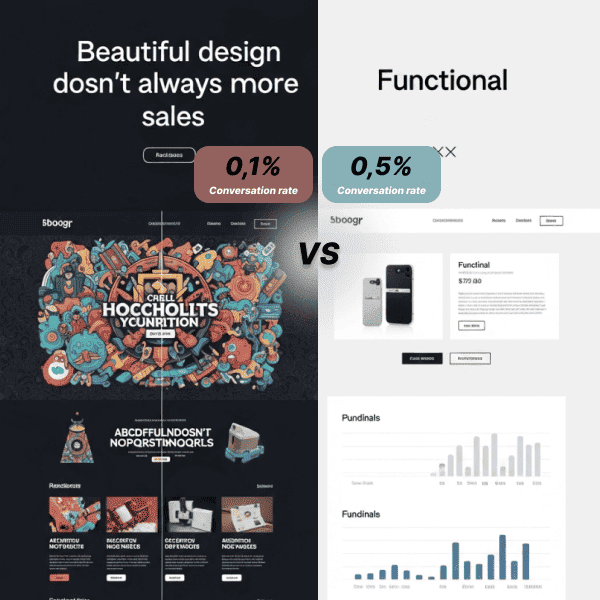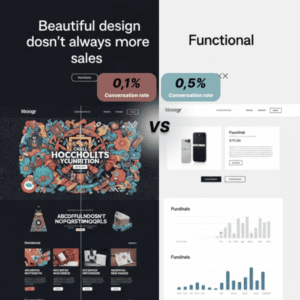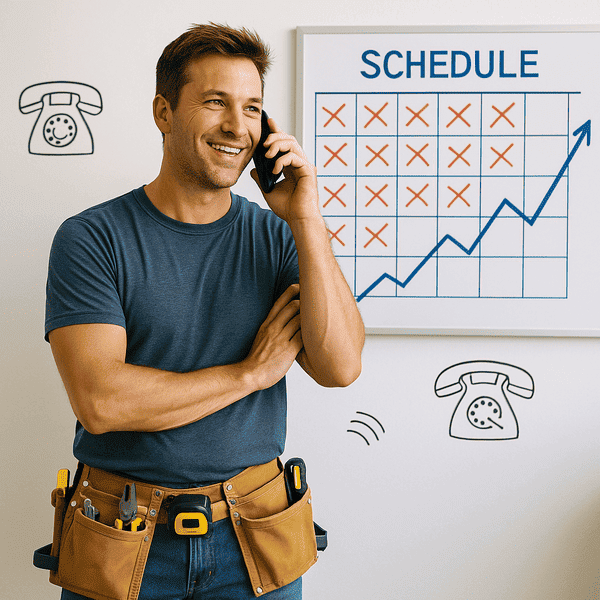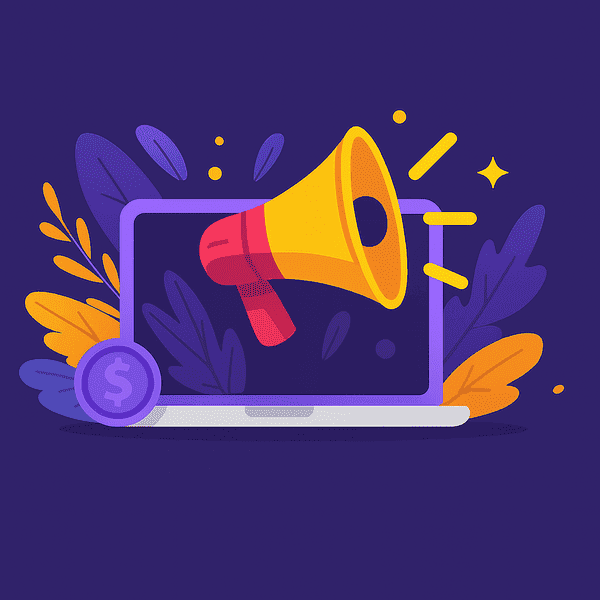Website conversion optimization is one of the most misunderstood aspects of web development, and this real-world case study demonstrates exactly why. Last week, I had a conversation with a colleague that perfectly illustrates how a stunning website redesign can accidentally kill your conversion rates and destroy business results overnight. Her company was facing a crisis – sales had completely dried up after launching what appeared to be a beautiful new website. The management was threatening layoffs within a week if the situation didn’t improve.
This scenario plays out more often than you might think, and it’s a stark reminder that when it comes to website conversion optimization, aesthetics and functionality don’t always align with profitability.

The Conversion Rate Problem: When Beautiful Websites Don’t Convert
My colleague’s situation was textbook: their old website was outdated and didn’t look competitive compared to industry leaders. The logical solution seemed obvious – invest in a modern, visually appealing redesign. The new site launched with contemporary design elements, improved visual hierarchy, and professional aesthetics that finally matched their competitors.
The result? Conversions plummeted to nearly zero.
Traffic was still coming through their social media advertising. Visitors were clicking through as before. But somewhere between landing on the new site and taking action, potential customers were disappearing into the digital ether.
A Personal Case Study: The Travel Agency Website Conversion Disaster
This situation reminded me of my own experience with a travel agency client several years ago. Initially, we had what I can only describe as a “frankly chaotic” landing page – multiple colors, inconsistent fonts, and a design that would make any modern designer cringe. Yet this unsightly page was a lead generation machine, consistently converting visitors into inquiries.
Convinced we could do better, we invested in creating a comprehensive, beautiful website. The new design featured:
- Professional photography of exotic destinations
- Intuitive search functionality for tourists
- Modern, clean layout with consistent branding
- Mobile-responsive design
- Comprehensive destination information
The website won design praise from everyone who saw it. The only problem? Lead generation dropped dramatically. What we had gained in visual appeal, we had lost in conversion effectiveness.
The Fundamental Misunderstanding About Website Purpose
Here’s where most businesses go wrong: they treat their website as a digital brochure rather than a conversion tool. This misconception leads to decisions that prioritize form over function, aesthetics over psychology, and brand image over business results.
A website should serve one primary purpose: converting visitors into customers. Everything else – brand presentation, information architecture, visual appeal – should support this core objective, not overshadow it.
What Makes a Website Convert: Essential Conversion Optimization Elements
1. Clear Value Proposition
Your visitors need to understand within seconds what you offer and why they should care. Beautiful design means nothing if your value proposition gets lost in artistic expression.
2. Strategic Visual Hierarchy
Every element on your page should guide visitors toward your desired action. This isn’t about making things pretty – it’s about creating a logical flow that naturally leads to conversion.
3. Compelling Product Presentation
In my colleague’s case, the new website lacked professional product photography that made visitors genuinely desire what was being offered. As I told her, “the photos need to make people’s mouths water for your product.”
4. Psychological Triggers
Effective websites leverage psychological principles like social proof, urgency, and loss aversion. These elements might not win design awards, but they win customers.
5. Streamlined User Journey
Complex navigation and excessive information can paralyze decision-making. Sometimes a simple, focused approach outperforms a comprehensive one.
The Design Agency Trap: Why Most Agencies Kill Conversion Rates
When selecting a web design company, many businesses fall into what I call “the portfolio trap.” They choose agencies based on visually impressive portfolios without asking the crucial question: “Do these beautiful websites actually convert?”
A design agency’s primary expertise lies in creating visually appealing interfaces. Unless they specialize in conversion optimization, their natural inclination is to prioritize aesthetics over performance. This isn’t malicious – it’s simply outside their core competency.
Red Flags in Web Design Projects
Be cautious if your design team focuses primarily on:
- Industry design trends rather than your specific conversion goals
- Visual impact over user behavior analysis
- Competitor aesthetics rather than competitor performance
- Brand consistency over conversion psychology
- Technical features over business objectives
Why Most Businesses Fail at Website Conversion Optimization
The fundamental issue isn’t just poor execution – it’s that most business owners and even web agencies don’t understand the psychology behind what makes visitors convert. They focus on surface-level improvements while missing the crucial elements that actually drive purchasing decisions.
Successful website conversion optimization requires deep understanding of user psychology, data analysis expertise, and extensive testing experience. It’s not something you can learn from a few blog posts or implement based on general best practices. Each industry, product, and target audience requires a unique approach based on behavioral data and conversion psychology principles.
Professional Photography: The Conversion Rate Driver Everyone Ignores
One critical insight from my colleague’s situation was the importance of professional product photography that creates immediate desire. As I told her directly: “the photos need to make people salivate over your product.” Visual presentation should trigger an emotional, almost physical response that makes visitors desperately want what you’re selling.
Investment in professional photography often yields higher conversion improvements than expensive design overhauls. Your product photos should literally make visitors’ mouths water with desire – they should trigger that visceral “I need this now” response that bypasses rational decision-making and goes straight to the purchase button.
When You Need Real Website Conversion Optimization Expertise
Given the complexity and specialized nature of effective conversion optimization, most businesses benefit from working with an expert who has extensive hands-on experience solving exactly these problems. The cost of getting it wrong – as demonstrated by my colleague’s situation – far exceeds the investment in working with someone who understands conversion psychology at a deep level.
Through years of working with businesses across various industries, I’ve developed proven methodologies for identifying conversion killers and implementing solutions that actually drive results. Each project teaches me more about what makes visitors convert, and this accumulated expertise is what separates successful optimization from expensive experiments.
The Recovery Strategy for Failed Website Conversions
If you find yourself in a situation similar to my colleague’s, here’s the recovery approach:
- Immediate Analysis: Identify exactly where visitors are dropping off in your conversion funnel
- Quick Wins: Implement rapid improvements to critical conversion elements
- A/B Testing: Compare new design elements against previous versions that worked
- Professional Assessment: Consider bringing in conversion optimization specialists
- Gradual Optimization: Make incremental improvements rather than wholesale changes
The Portfolio Paradox: Why Experience Matters More Than Case Studies
Here’s an uncomfortable truth about the web development industry: many agencies with impressive portfolios focus on winning design awards rather than driving business results. They showcase beautiful websites that may or may not actually convert visitors into customers.
What matters more than a flashy portfolio is deep understanding of conversion psychology and the ability to diagnose why websites fail to convert. Sometimes the most valuable expertise comes from analyzing failed projects and understanding exactly what went wrong – like recognizing that a beautiful new website killed conversion rates by prioritizing aesthetics over functionality.
The Long-term Perspective on Website Conversion Optimization
Successful websites evolve continuously. They’re not static art pieces but dynamic tools that adapt based on user behavior, market changes, and business objectives. The most profitable websites often look less “perfect” than their showcase counterparts because they prioritize function over form.
Conclusion: Beauty vs. Performance in Website Conversion Design
The story of my colleague’s conversion crisis serves as a powerful reminder that in website conversion optimization, beautiful design doesn’t automatically translate to business success. A website is ultimately a tool designed to turn visitors into customers, and every design decision should support this primary objective.
Before embarking on your next website project, remember: seek a partner who understands that your website isn’t just a digital business card – it’s your most important sales tool. The goal isn’t to win design awards; it’s to win customers.
Sometimes the most effective websites aren’t the prettiest ones, but they’re always the ones that convert visitors into revenue. In the end, that’s the only metric that truly matters for business success.






